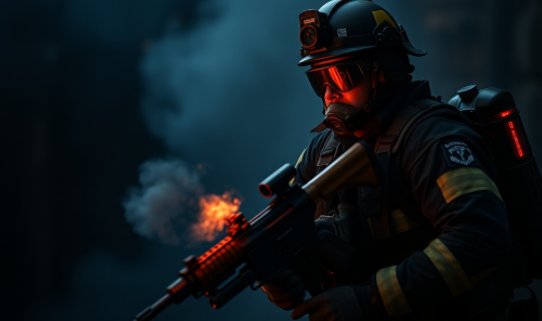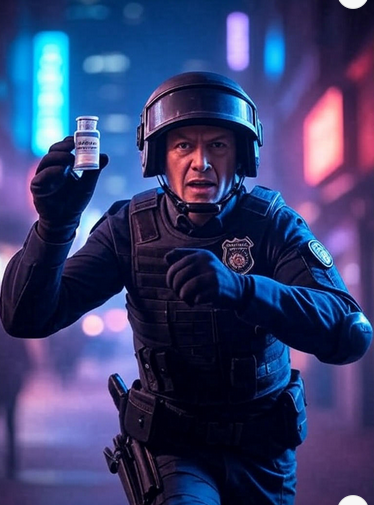They train how to stand in the Academy for safety reasons...it is a good start...how can we make it better?
Key Takeaway
In the Academy it is rightly taught for Police Officers to stand in a modified fighting position when talking to people on the street. When possible, he or she should also have their hands up in a non threatening posture in the event they need to defend themselves.
This is something these professionals should always do; not because they should be paranoid that they’re always going to get hit, but just to maintain the habit. Because when, not if, that moment occurs where you’re dealing with that roughly 10% of the population that commits most of the violent crime in the community you have at least given yourself some chance to react.
What if we take this concept a step further and bring in the principles used by elite athletes for decades? Watch the video below. Look at the officer’s stance, his initial reaction, and the direction he moves. Was he ready?
If the Officer in this video somehow sees this post…I am not critiquing you in a mean spirited way or second guessing you…I am just trying to help people get better. It is awesome seeing guys out there doing the job. Thank you for what you do.
Proper Stance- Basic Athletic Position
Unfortunately, officers can get complacent and you’ll seem them standing flatfooted while conducting street level investigations. I know I did it sometimes. We get too comfortable in the “routine” interactions and only look ready for a few reasons:
-Nature of the call. For example, caller states the person is high on PCP and armed.
-We are contacting somebody that has demonstrated their willingness to do violence in the past
-current body language.
-Totality of the circumstances…An example being you’re on a traffic stop and right before the vehicle stopped the driver clearly shoved something under the seat.
That was certainly not an all inclusive list, but we have to be ready regardless of the situation. If you got out of your patrol vehicle to lawfully make contact with an individual anything can happen. Be ready.
Another component to this is if you approach the person in a relatively athletic position, your professional, and in shape…the body language you are demonstrating is that you are ready. This may give them pause when deciding whether or not to run or fight.
How To Train This- Gym vs Real World
Much like with various martial arts you go in the gym and you learn basic concepts that almost always need to be slightly modified in application for the street. Learning boxing or Brazilian Jujitsu and training it the gym are phenomenal tools to learn how to defend yourself or control a suspect. It should be mandatory.
However, I don’t think in a street fight you would jump on your suspect and slam yourself on your back into a guard position onto concrete to try to work your opponent into a hold like you might do in a BJJ competition. It’s the sport vs real world debate that always happens on this topic. This doesn’t mean don’t train BJJ because it’s supposedly useless like some might argue, it just means you need to apply different principles when you add in all the variables of an encounter.
The same could be said for boxing. Under Olympic boxing rules you can’t punch someone in their back or on the back of the head. Obviously on the street there are no such rules and no referee is going to separate you in the event that happens. That doesn’t mean spending some time refining your boxing fundamentals to learn the importance of distance or how to throw a punch would be a waste of time. Common sense.
How To Train This- Drills
We will apply the same thing to sprint starts…both linear and lateral variations. I know you will never be able to freeze yourself in a staggered position on the street most of the time, but we are just training mechanics. Training you to feel your body’s position. Where are your feet? Are you balanced? Are learning to move from this position without wasting movement or taking a step back first? Elite athletes do this ALL the time. Whether it be in team sports or track events. You should do the same.
Standing Variations:
Notice how on both the linear and lateral standing starts the idea here is to train us to only move in the direction we are trying to go. There is no stepping back, no wasted movement but instead lean in the direction you want to go and then go. You can see how on the lateral option I not only do a split stance starting position, but also a more “base position” or linebacker start. On the street you might not be in one of these positions exactly, but again we are just training concepts.
Kneeling Variations
Kneeling variations are a bit more challenging. You have to start from a true “dead stop” position which requires some strength and coordination, and the first time you do it you’ll feel pretty slow. It’s OK, you’ll figure it out and learn how to move better. More importantly, when you do this standing again you’ll feel even faster.
In the lateral kneeling start video, you’ll notice I add in some more reactive work in the second half of the video by starting with a jump from the kneeling position and then taking off. That is slightly more advanced but it is just one way to add in some variables as you get better at the initial progressions. You will always need to challenge yourself a bit more as you improve and the options are endless. You could do this in uniform to add a little load, or you could hold a weight on the jump and then drop it before running for a contrast.
Closing
I am sure after those videos start making the rounds the NFL recruiters will be calling, but unfortunately I have a hip replacement so I think my playing days over. However, regardless of where you are…whether you’re 40 like me with a bionic hip or you’re 22 and just starting out as a first responder…if you don’t drill this stuff when the stress hits your body you will just react however it is going to react and it probably won’t be pretty. Practice it just like you practice any other skill you will need in the course of your duties.
We will be adding work like this into our future phases. This is something I have overlooked in our warm ups, and I acknowledge this will be tough to coach through the TrainHeroic App. With that said I am always a message away on the app if you need help.
If you aren’t training with us yet, there is still time to use the code ENDURING2026 for 40% on your first month through the end of November.
And even if you don’t train with us, if you have questions or want advice on how you could incorporate this into your own training or your agency’s training please comment below. Yes, we would love to have you subscribe but we are also just here to help.
Stay safe.



